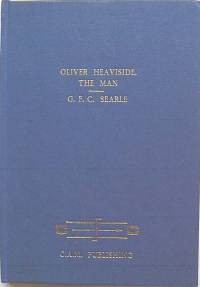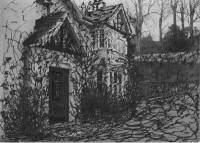OLIVER HEAVISIDE, THE MAN

By G. F. C. Searle (Edited by Ivor Catt)
1987, C. A. M. Publishing
St. Albans, England
ISBN: 0-906340-05-5
ivorcatt@gmail.com
Editor’s Preface
Ivor Catt, Januray 1987
This volume is worth reading for three reasons. Firstly, it is about one of the greatest eccentrics, and secondly it is about one of our greatest scientists. It is the only published biography of Oliver Heaviside. The third reason for reading it is limited to students of science and the sociology of science. The behavior of the scientific establishment when faced by the brilliance of of Heaviside was intensely political and destructive. It is important for scientists to be made aware of the irresponsible behavior of leaders of learned establishments when faced by a threat to their position in the form of scientific breakthroughs. A century later, I myself met with exactly the same kind of behavior from leaders of the I.E.E., the Institute of Physics, the professors of Electrical Engineering and so on when in my turn I produced major advances in electromagnetic theory. Like Heaviside’s, my work was suppressed – in my case for more than ten years. Fortunately the suppression has now ended, and I publish again in the top journals and convereneces. Ten years is a long time however, and I fully understand why Heaviside was permanently scared, as I am oftern said to have been.
The judgement of history is frivolous.Oliver Heaviside almost disappeared from the record for the last fity years. During that period he is unreferenced in any text book on electromagnetic theory., although his contribution to the subject is as important as anyone’s. I mayself researched the subject for twelve years without coming across his work. I was meanwhile in the process of re-discovering things known by Heaviside a century before, when one day a non-scientist led me to him.
Searle, Heaviside’s friend, was worried about the lack of recognition neted out to Heaviside. Around 1950 he wrote a biography to help to right the wrong beeing done to his by history. This remained unpublished until the manuscript was recently discovered by me in romantic circumstances.
For recent background on the continuing problem of suppression in science, I recommend my articles in Electronics and Wireless world, December 87 and January 88.
Introduction
G. F. C. Searle
In the following sketch I have attempted to give a pen picture of Oliver Heaviside as Mrs. Searle and I knew him. I have hardly touched on the scientific side, although I had many rather closes contacts with him in some of his work; some of these contacts may be seen in my published papers. I understand that a set of such “contact” papers will be preserved at the Institution of Electrical Engineers in connexion with the Heaviside collection of papers. Professor Willis Jackson refers to some of the inter-action between Oliver and me in his aprreciation of Oliver’s published work. Any account I could have given of Oliver’s mathematical and electro-magnetic work would have tooched only a small part of the amazing totality of his output. It seemed best, therefore, to abandon any serious attempt in that dirction, and to confine myself mainly to a description of the man Oliver Heaviside, as i saw him. We always spoke of him, in an affectionate way, as “Oliver”, or sometimes “O.H.”, and that habit has persisted in this sketch.
The account I offer deals more with incidents than with a connected history. To recordwhere he lived at various times, when Miss Way left Homefield and his final illness and death would be an easy task, once the data were collected. What has not been so easy is to describe his ways, his outlook of life and his contacts with others. Little would have been gained if I had been able to weave all the incidents and all his outbursts of opinion into a “history”, and I have not attempted it. The incidents which occured in my own experience or in that of others may be counted as “history”.
A good deal of other matter has been derived from letters written by Oliver. Of the many letters he wrote to me in a friendship of thirty three years, only a few were on electromagnetic or on mathematical subjects. Some were encouraging, others pointed out where I had made mistakes or was dull of understanding. Most of his letters dealt with “domestic” affairs and were often very intimate. A good deal has been taken from these “domestic” letters, some would contain as many as three thousand words. In my selection, I have used some discretion.
Heaviside wrote many letters to others. By the kindness of Mrs. Lorna Langley-Kramer, a daughter of the late Sir Oliver Lodge, I have been able to make some use of the pile of letters Sir Oliver received from heaviside. (Now at the library of University College, London. – Ed.) Most of the letters were occupied with electrical matters and intimate or domestic affairs found little place. To make any use of the “electrical” letters to Lodge, it would be necessary to compare them with the opposite letters from Lodge to Oliver, some of which are in the posession of the I.E.E. The study might be profitable. I have not attempted to deal with theses “electrical” letters, since a study of them would be outside the limits imposed on my memoir.

Heaviside’s home as Searle saw it in 1920
Professor V. Bjerknes, of Oslo, has allowed me to use several letters which Oliver sent him. The later ones deal largely with home affairs at “Homefield”.
The record I offer is necesssarily a disjointed one, but I console myself with the thought that although the pictures in a gallery are in separate frames and do not form a single panorama, yet each may be of some interest.
Mary Sharp in 1790 worked on a needlework sampler, n ow in the Fitzwilliam Museum, Cambridge, the following lines
This gift, my friend,
To thee I send,
In hope to be approved.
I have done my best
I do protest,
For one so well beloved.
Her words seem to express the spirit in which I have tried to write of my friend Oliver Heaviside.
http://www.forrestbishop.mysite.com/OHM/Heaviside_the_Man.htm